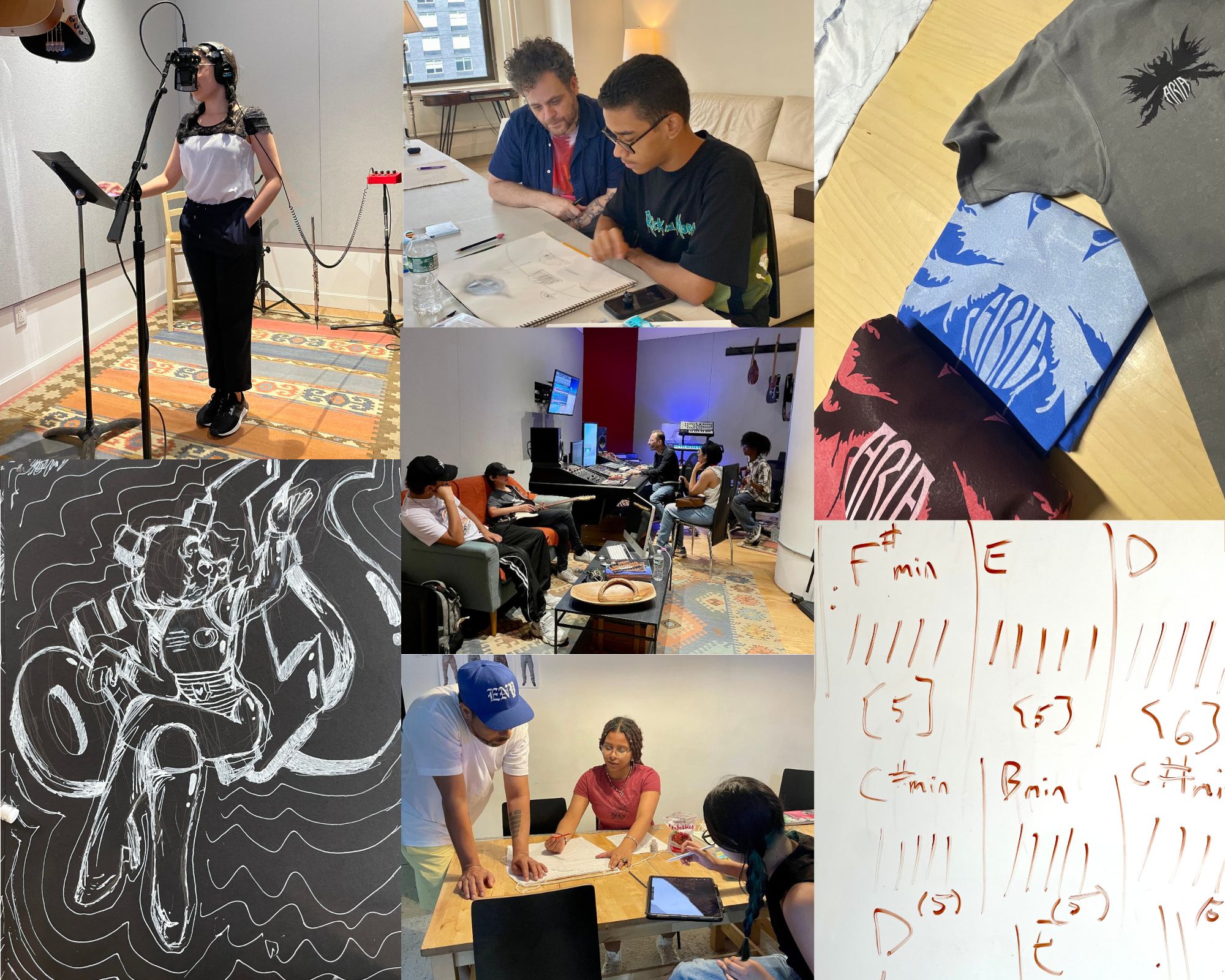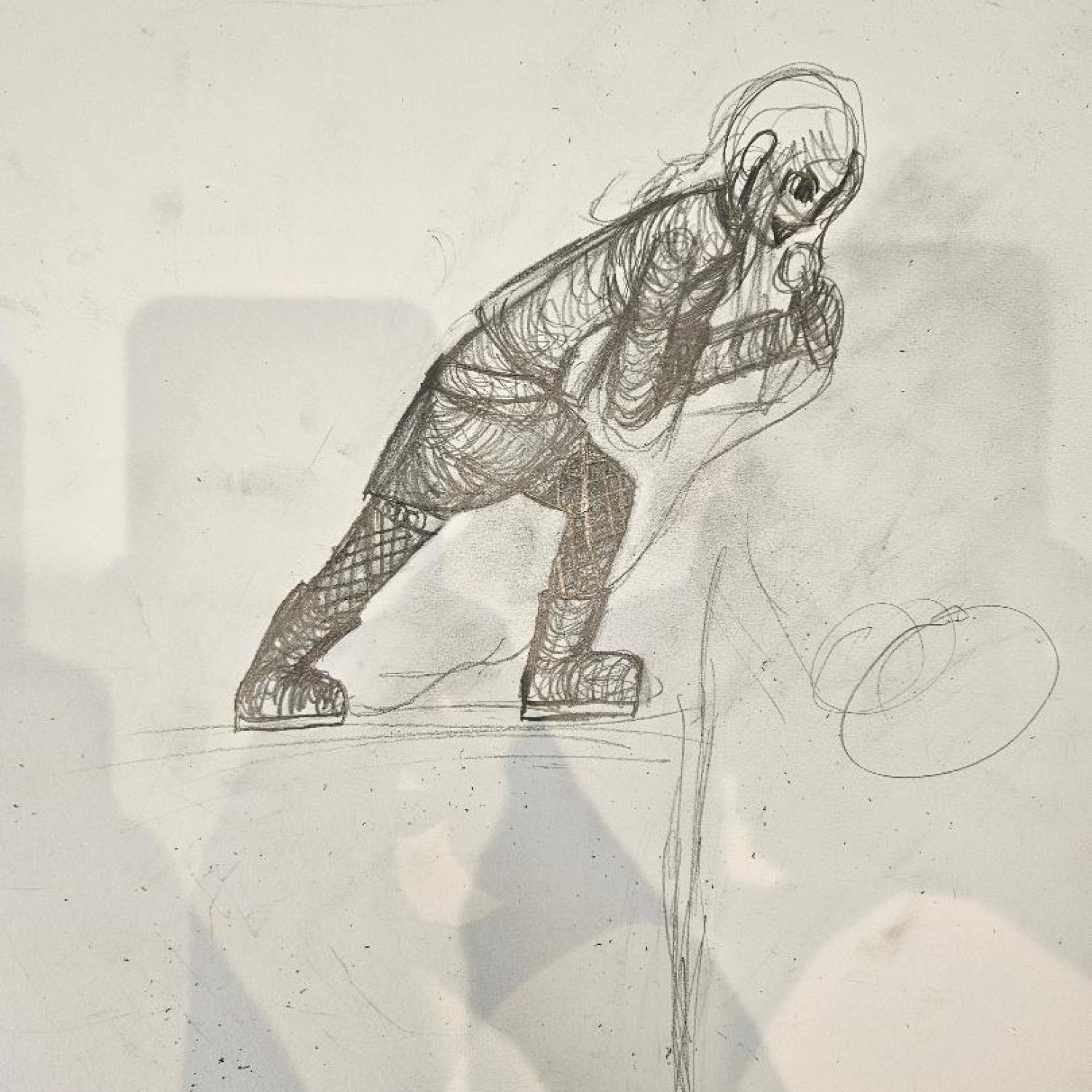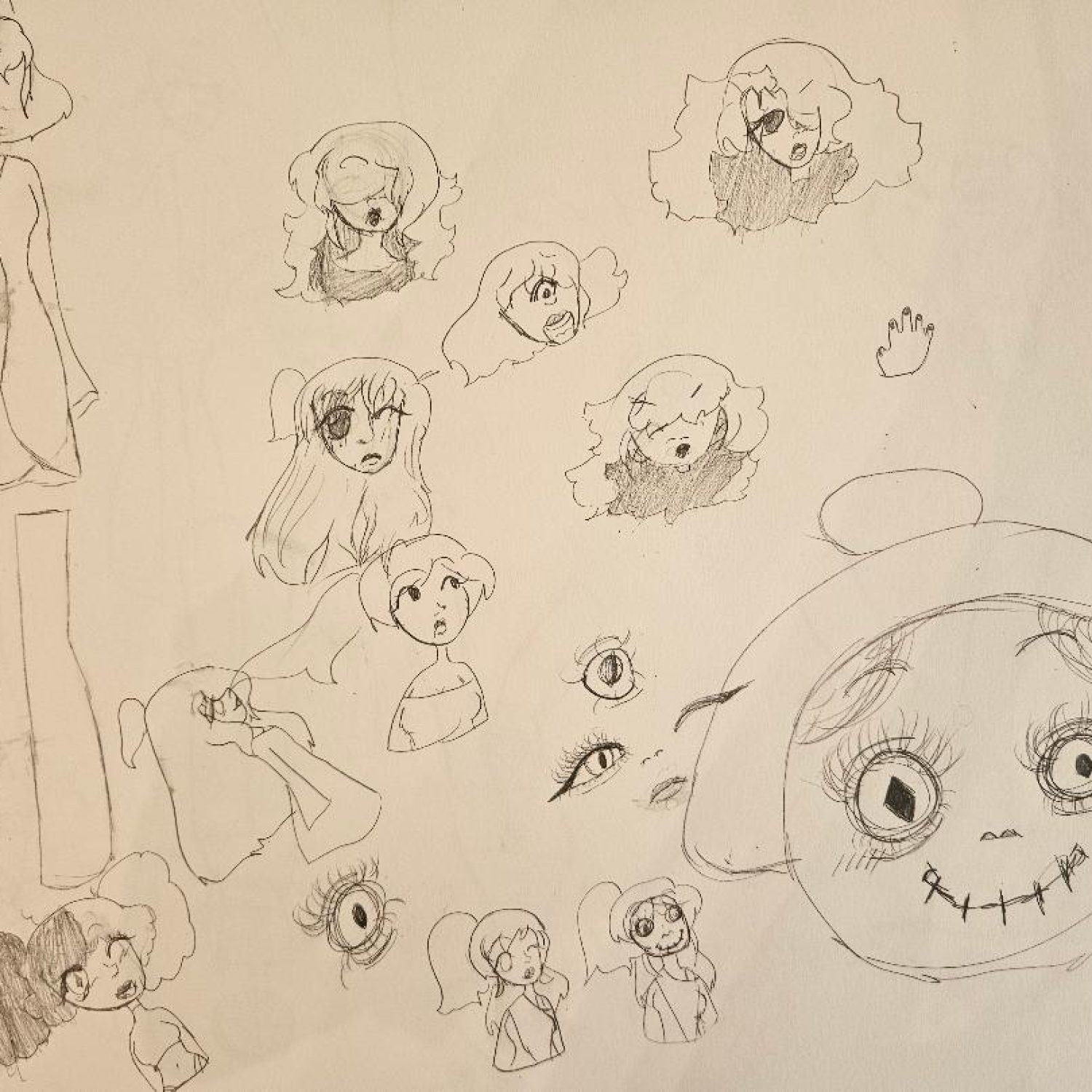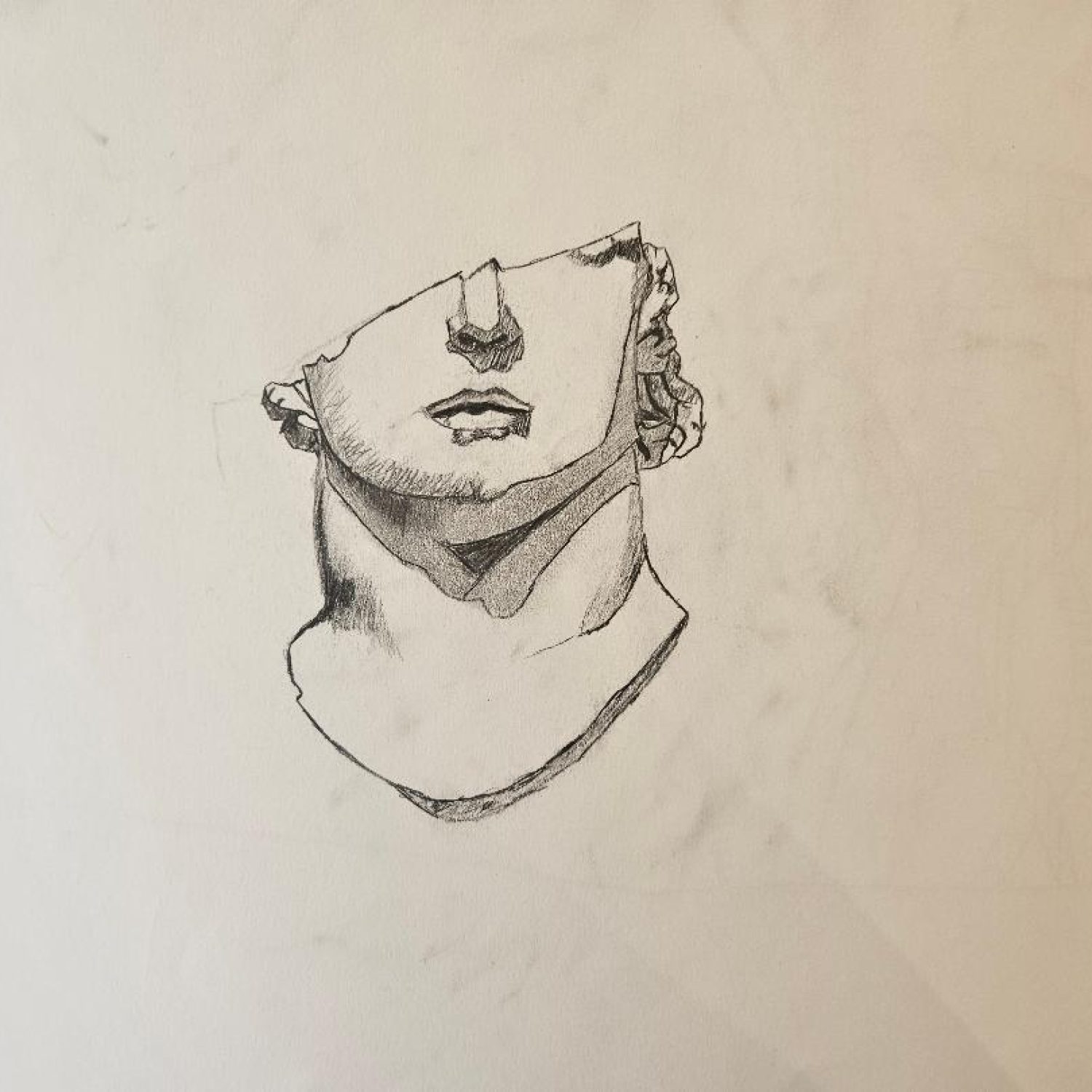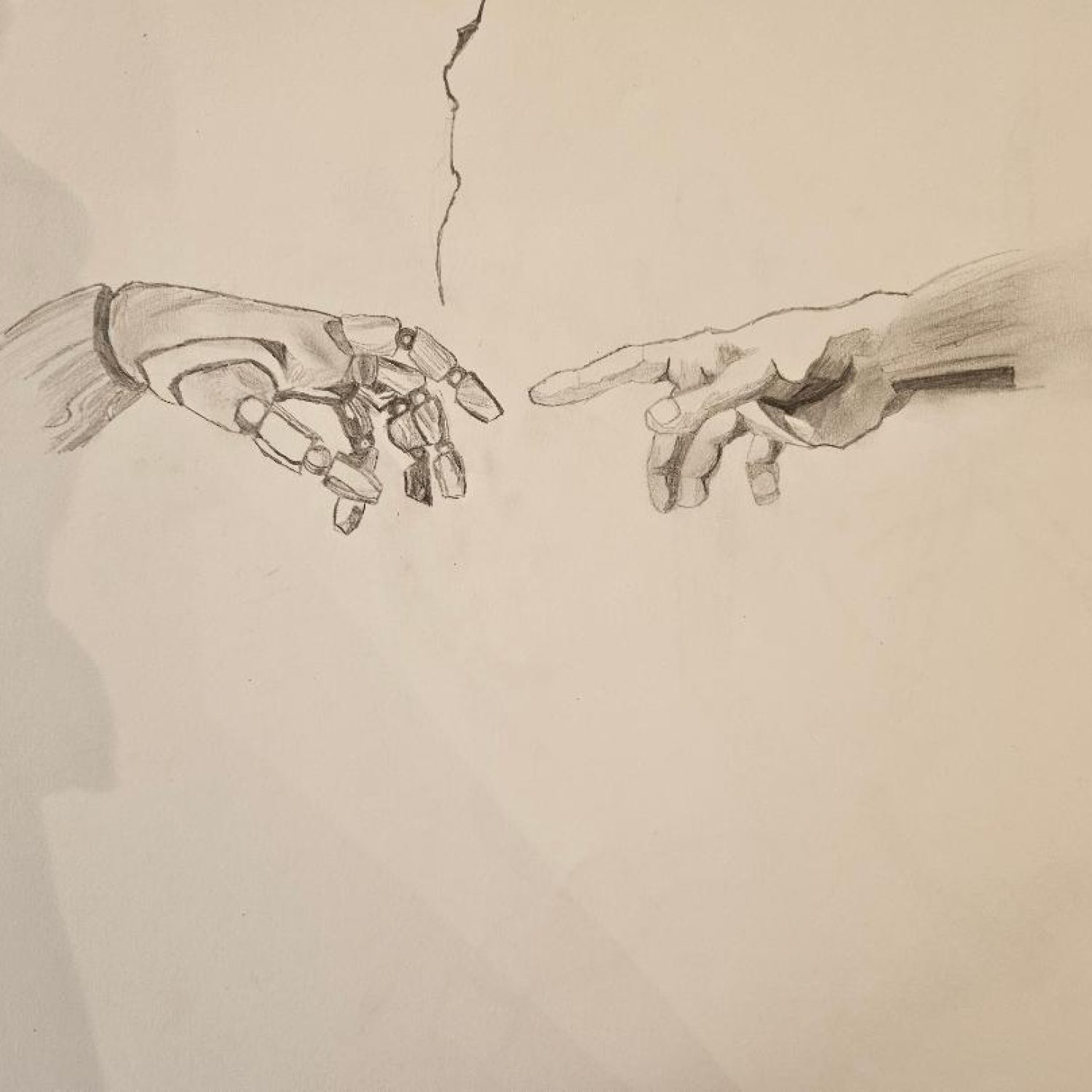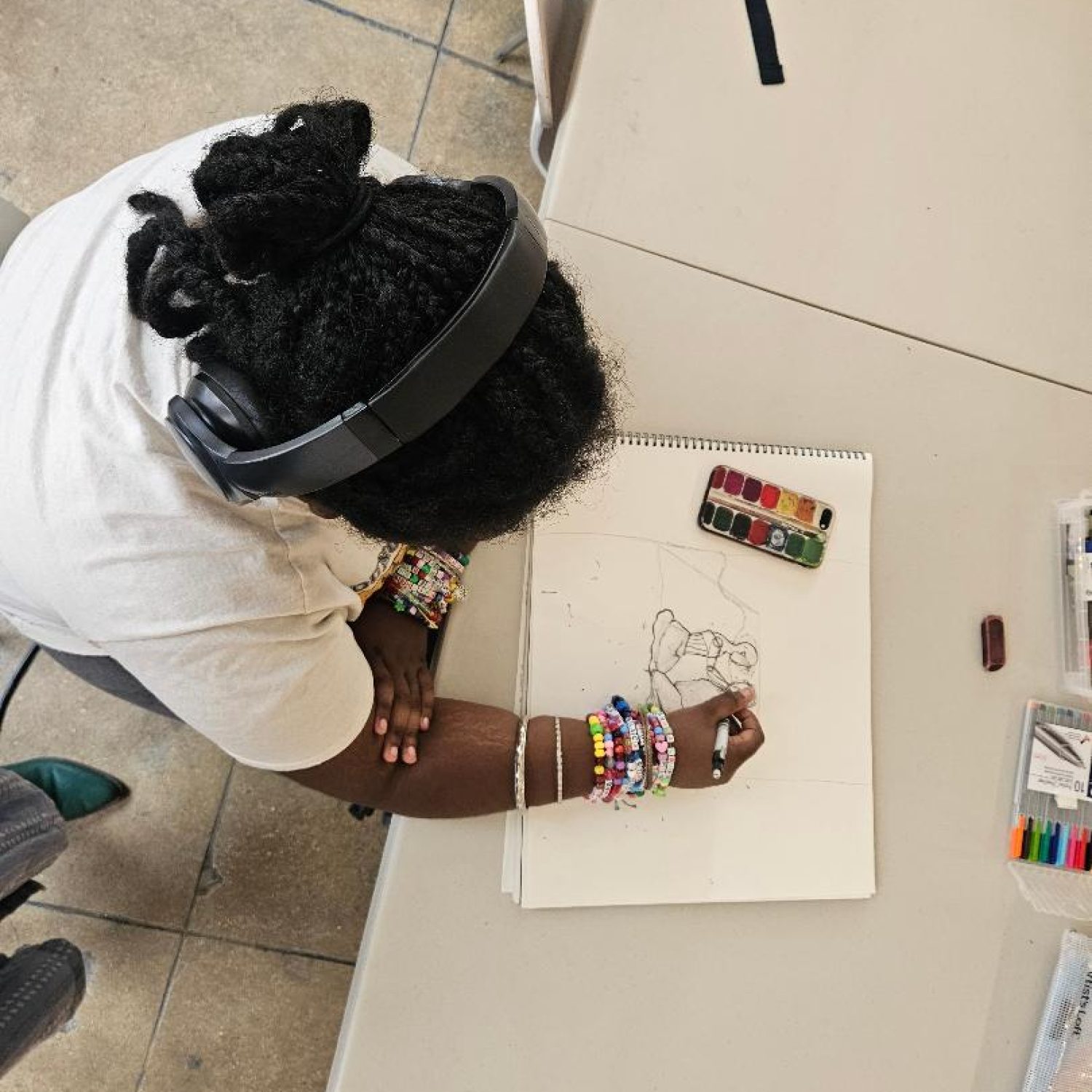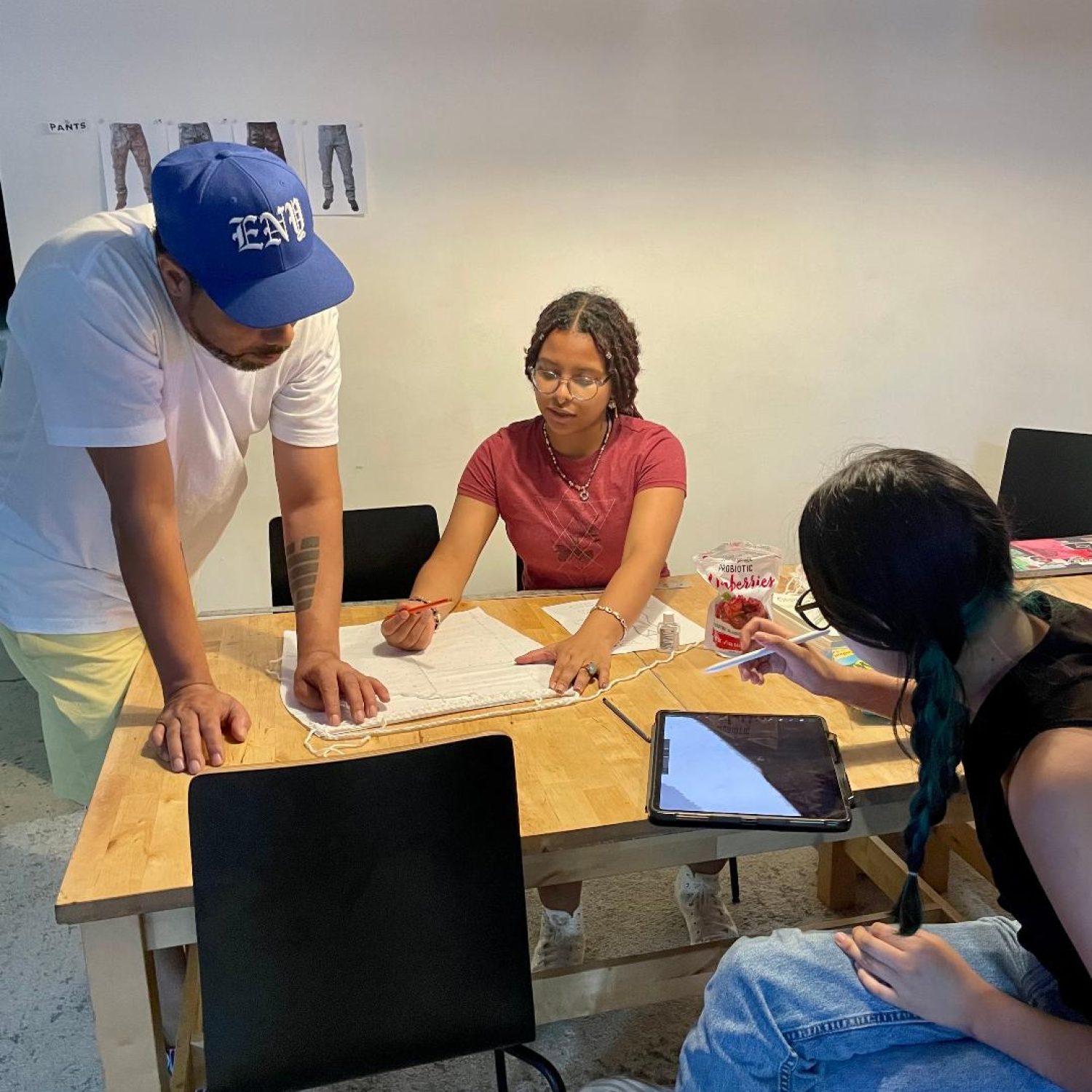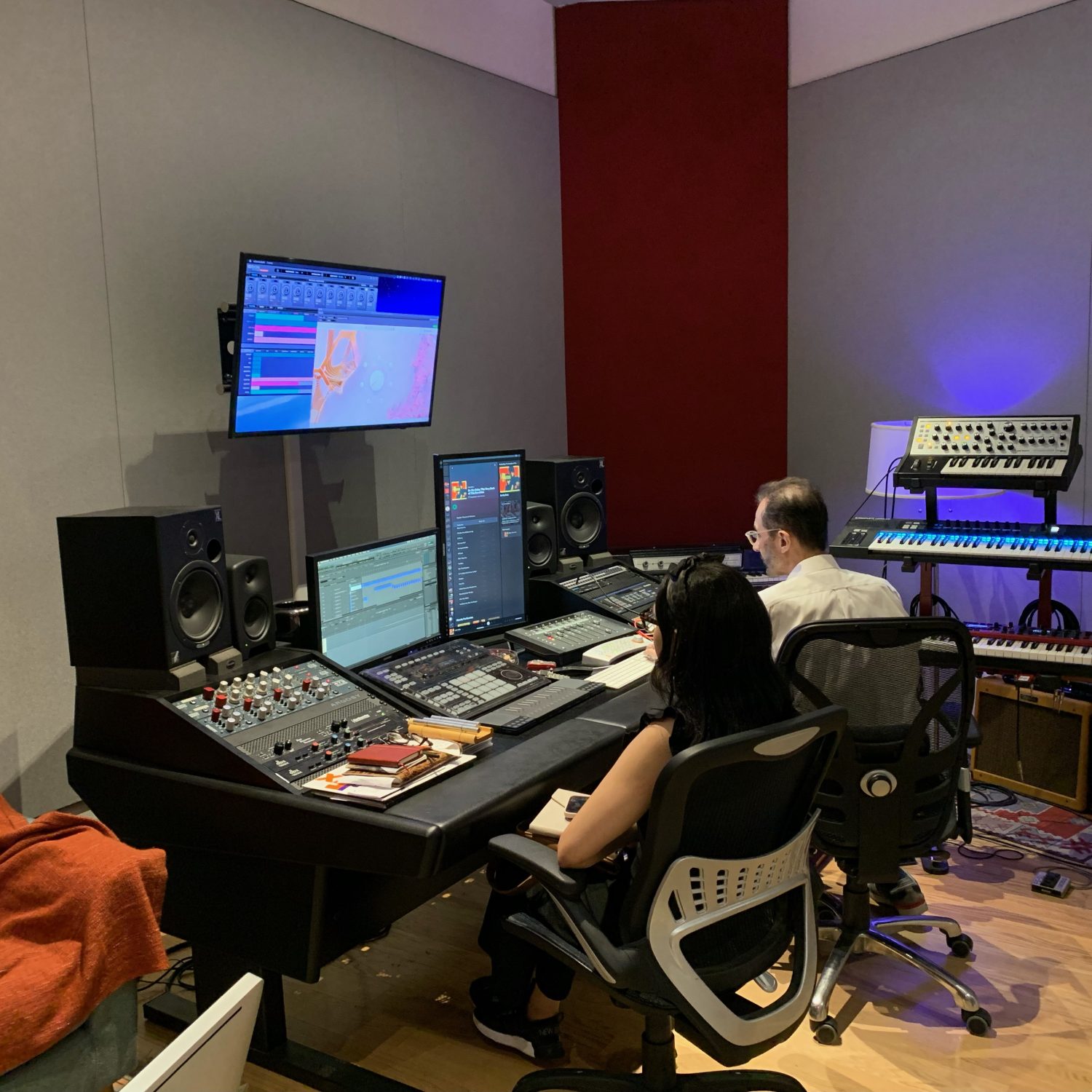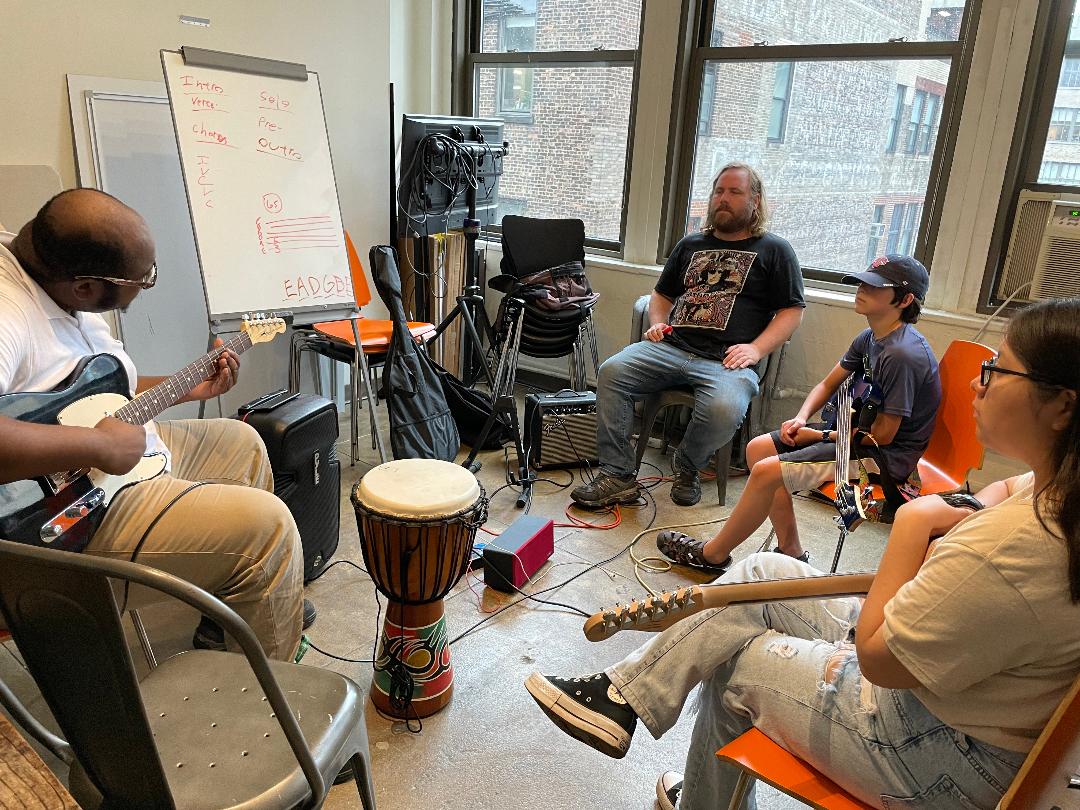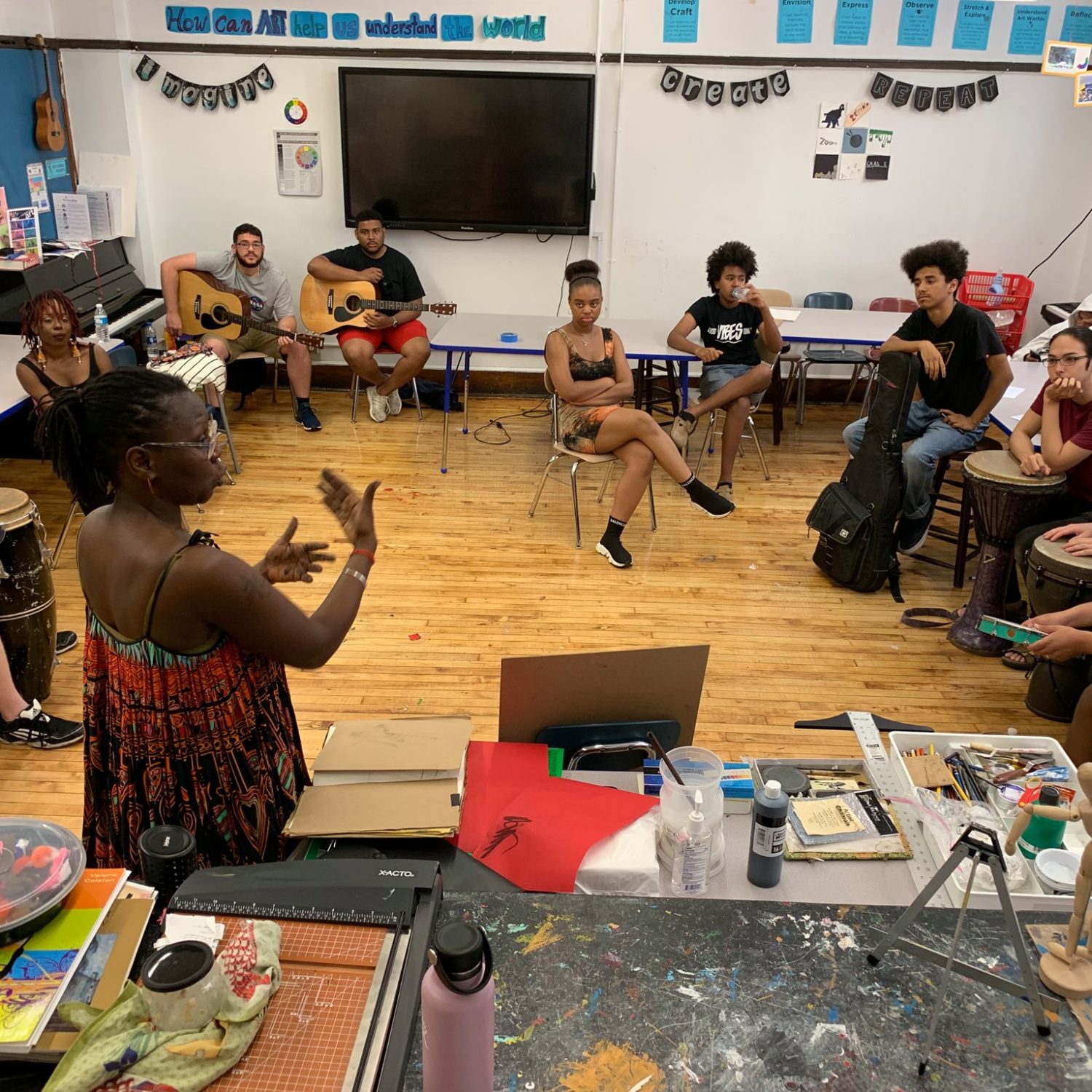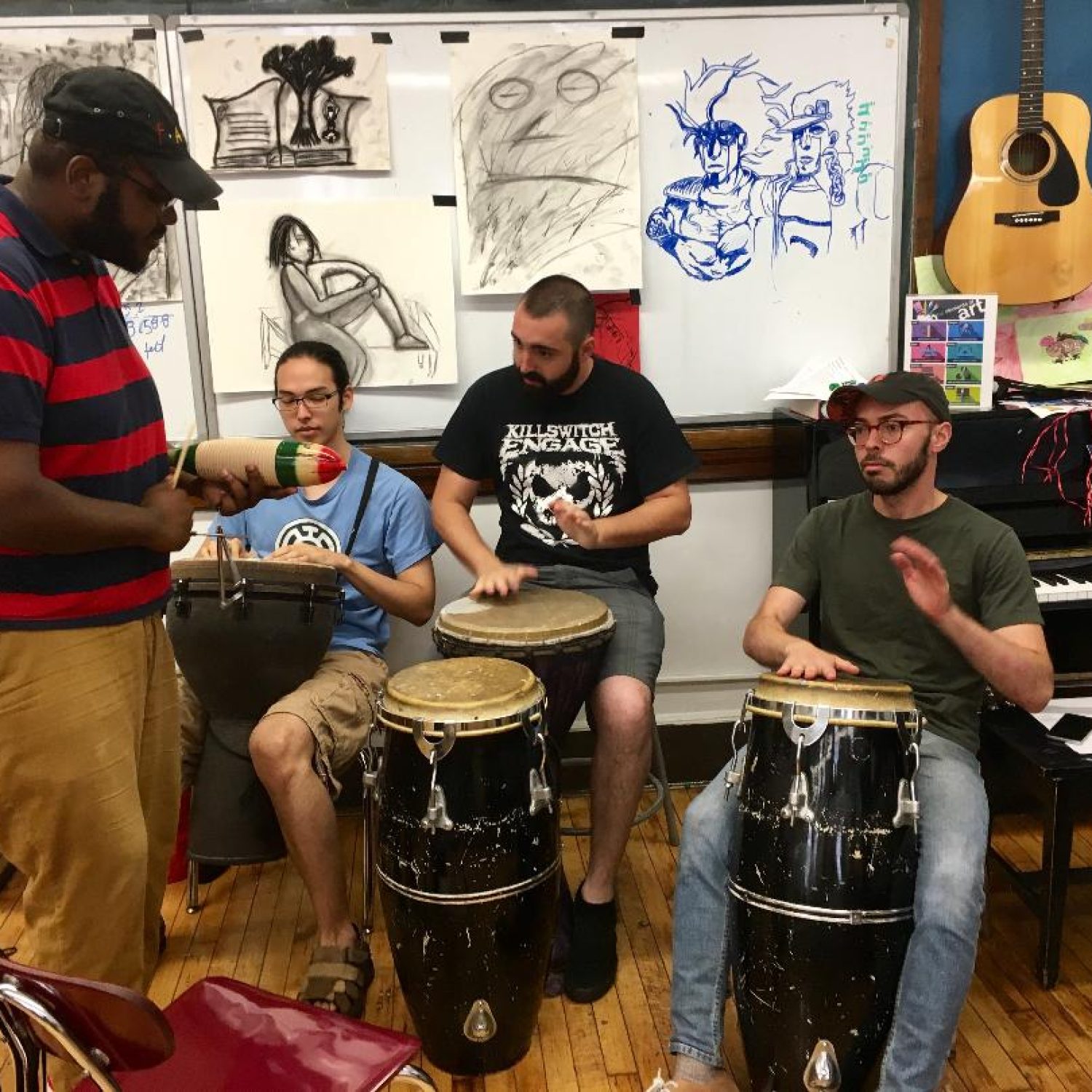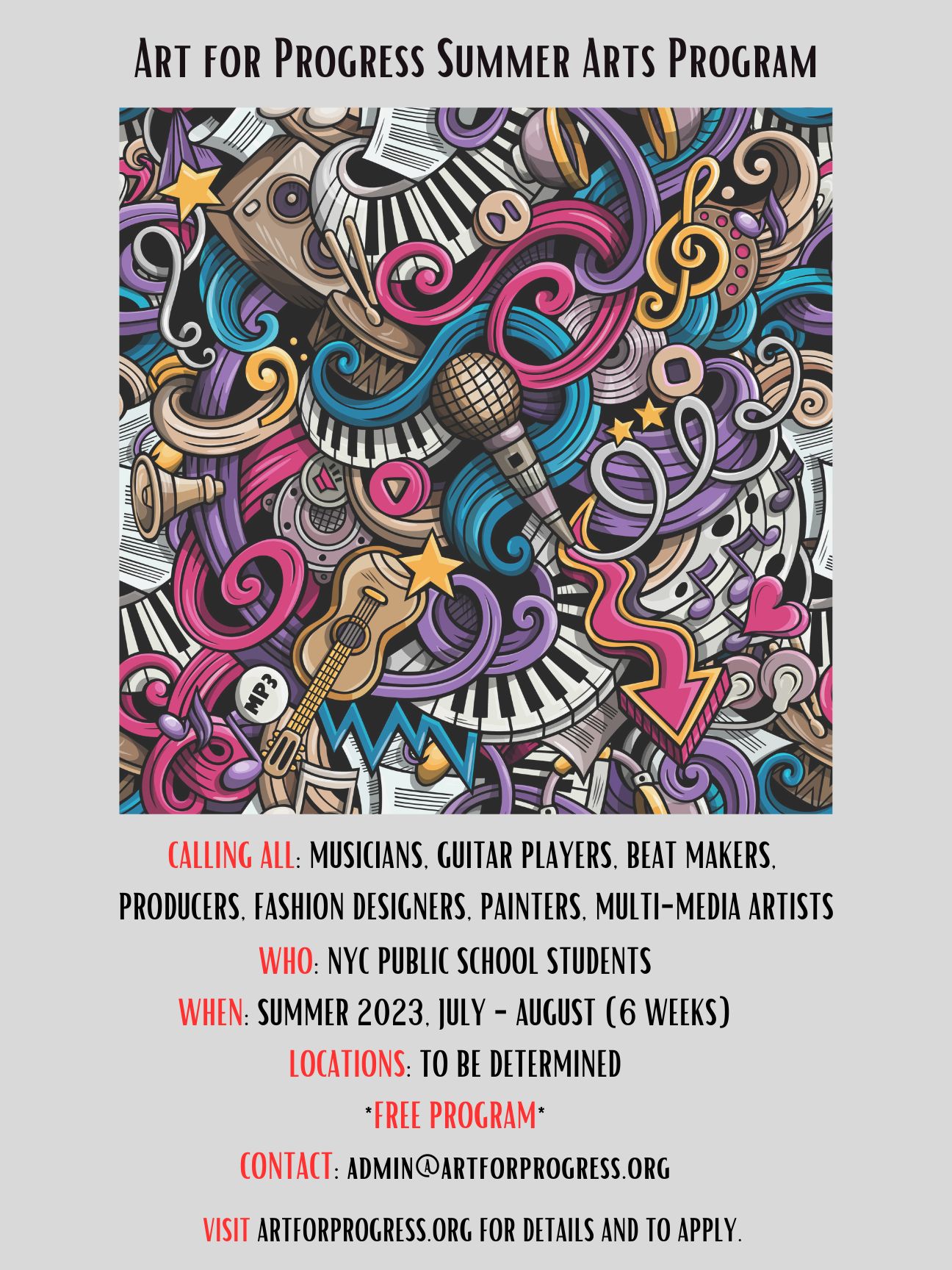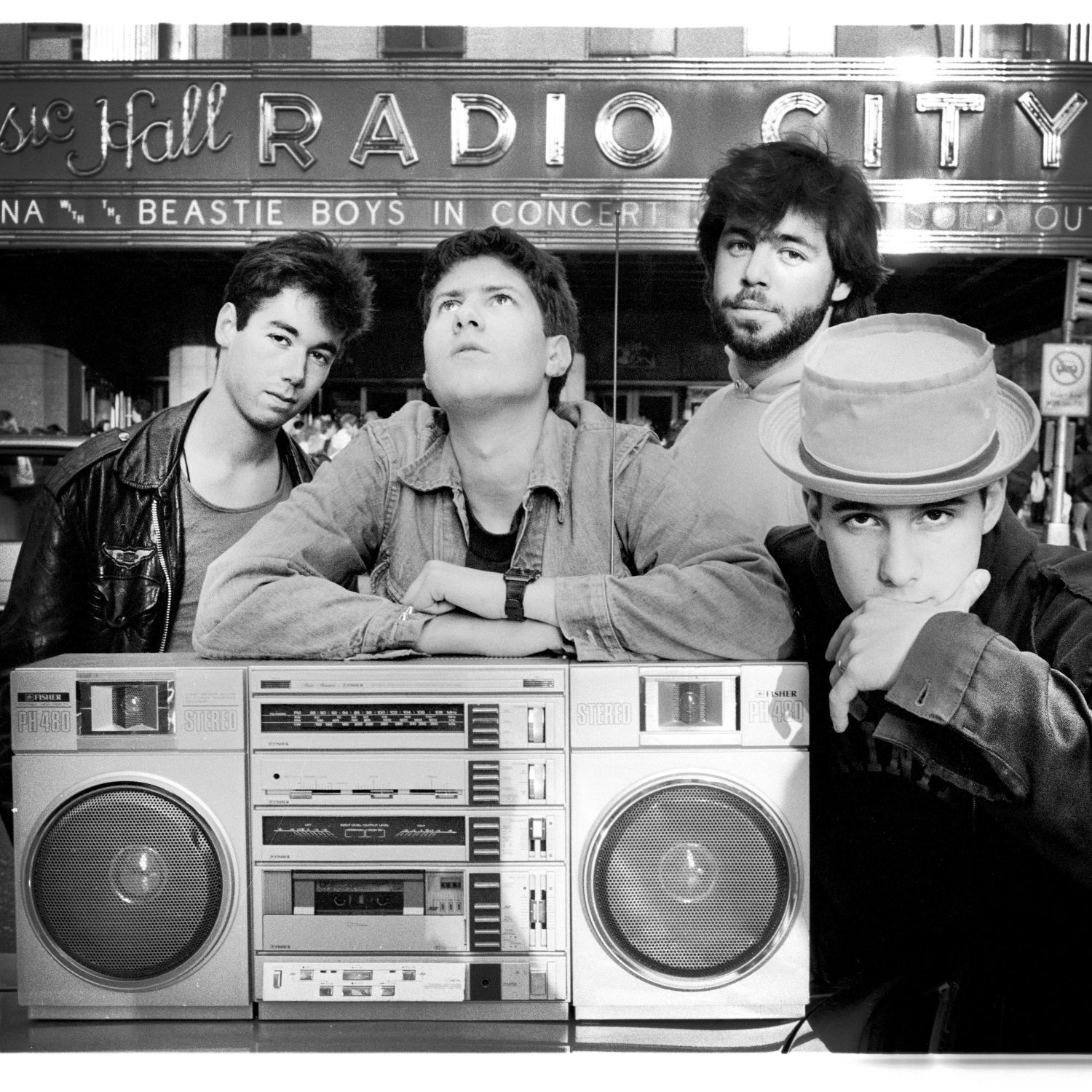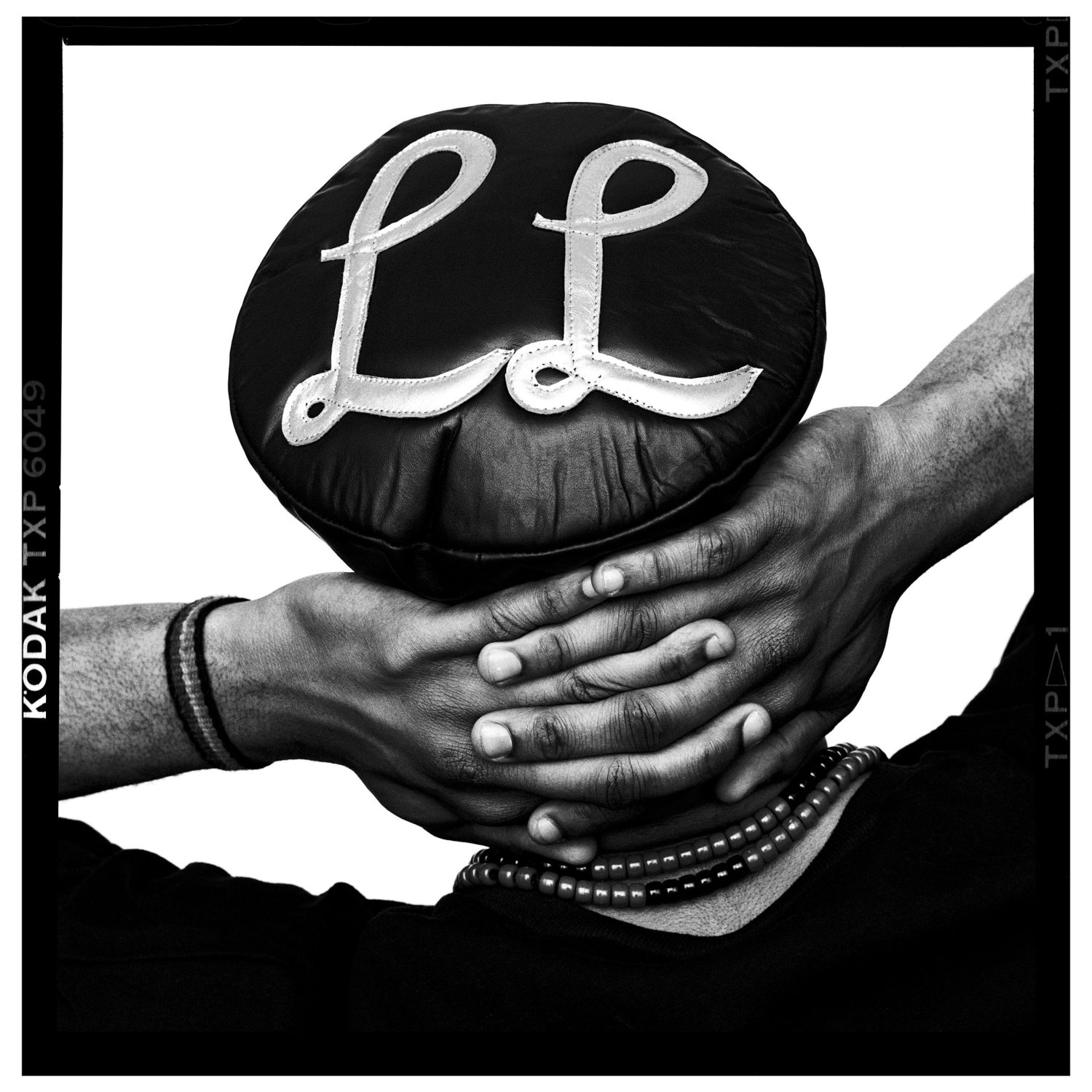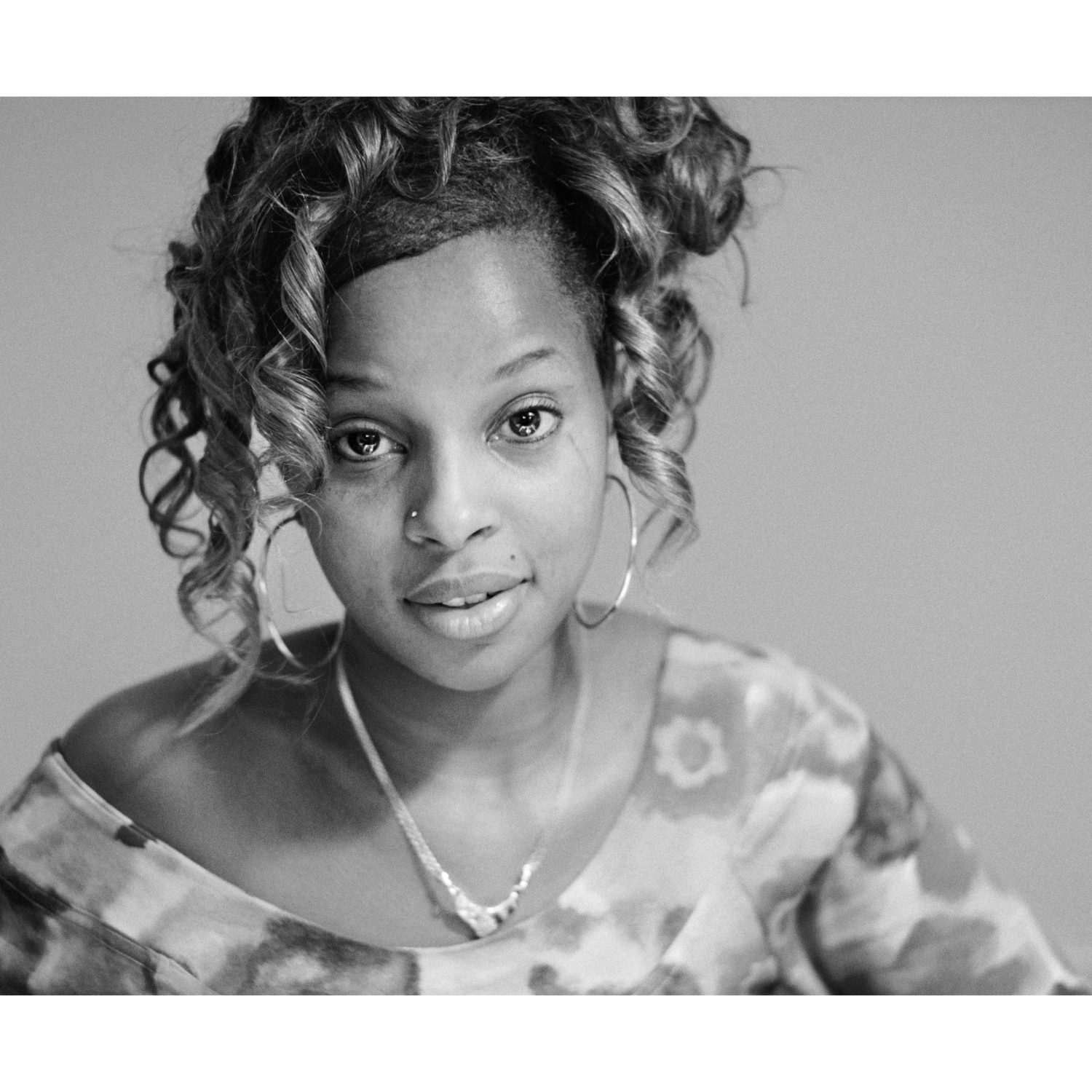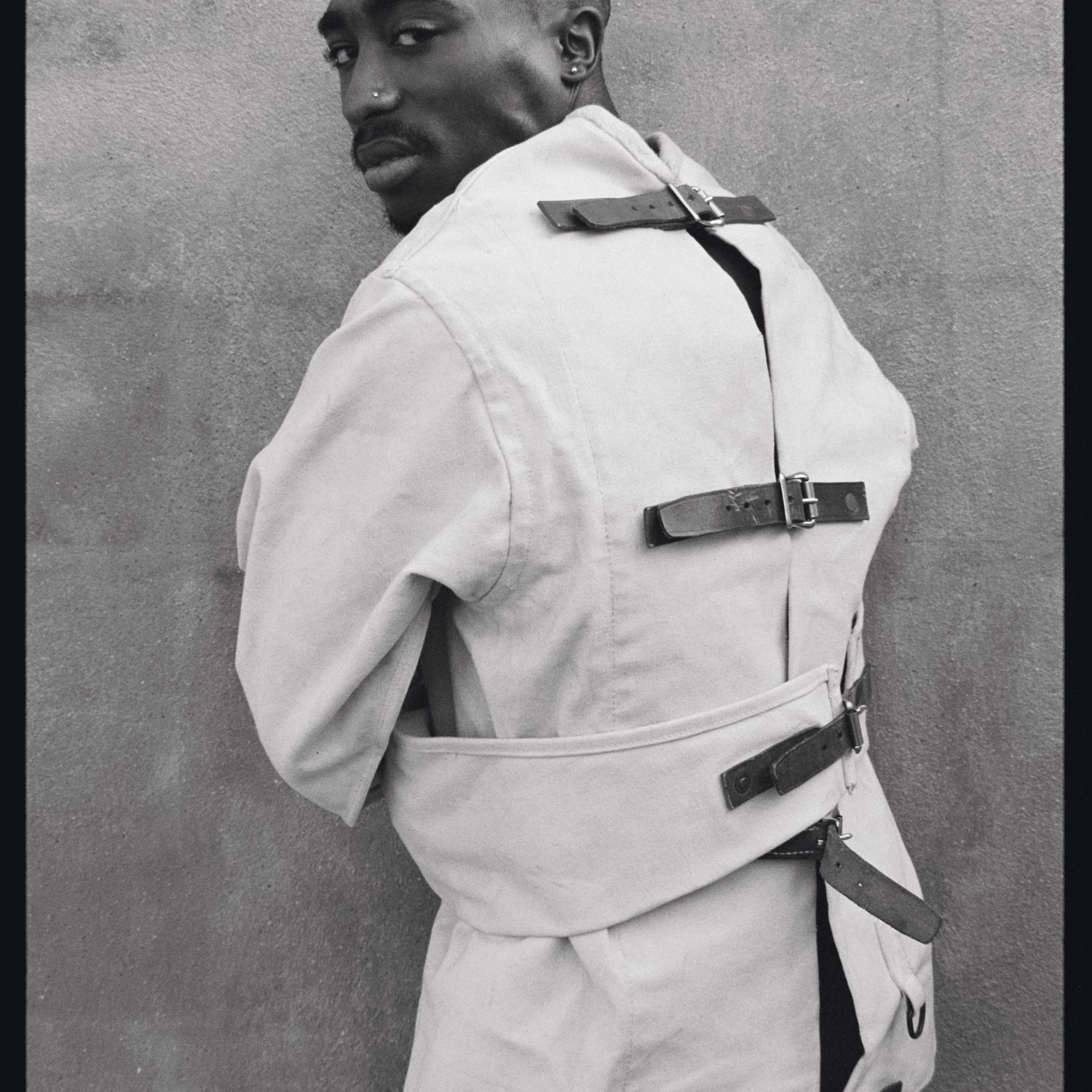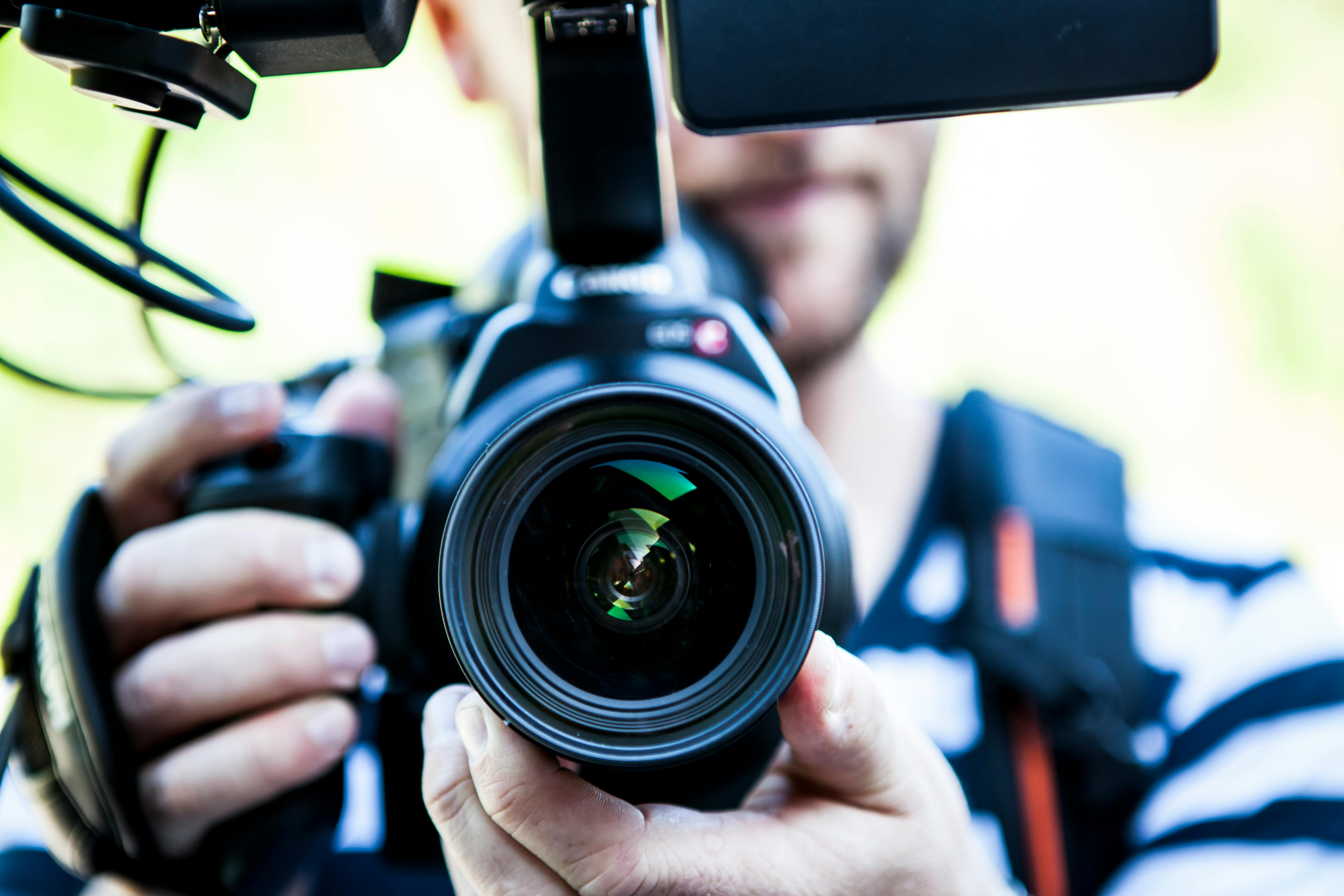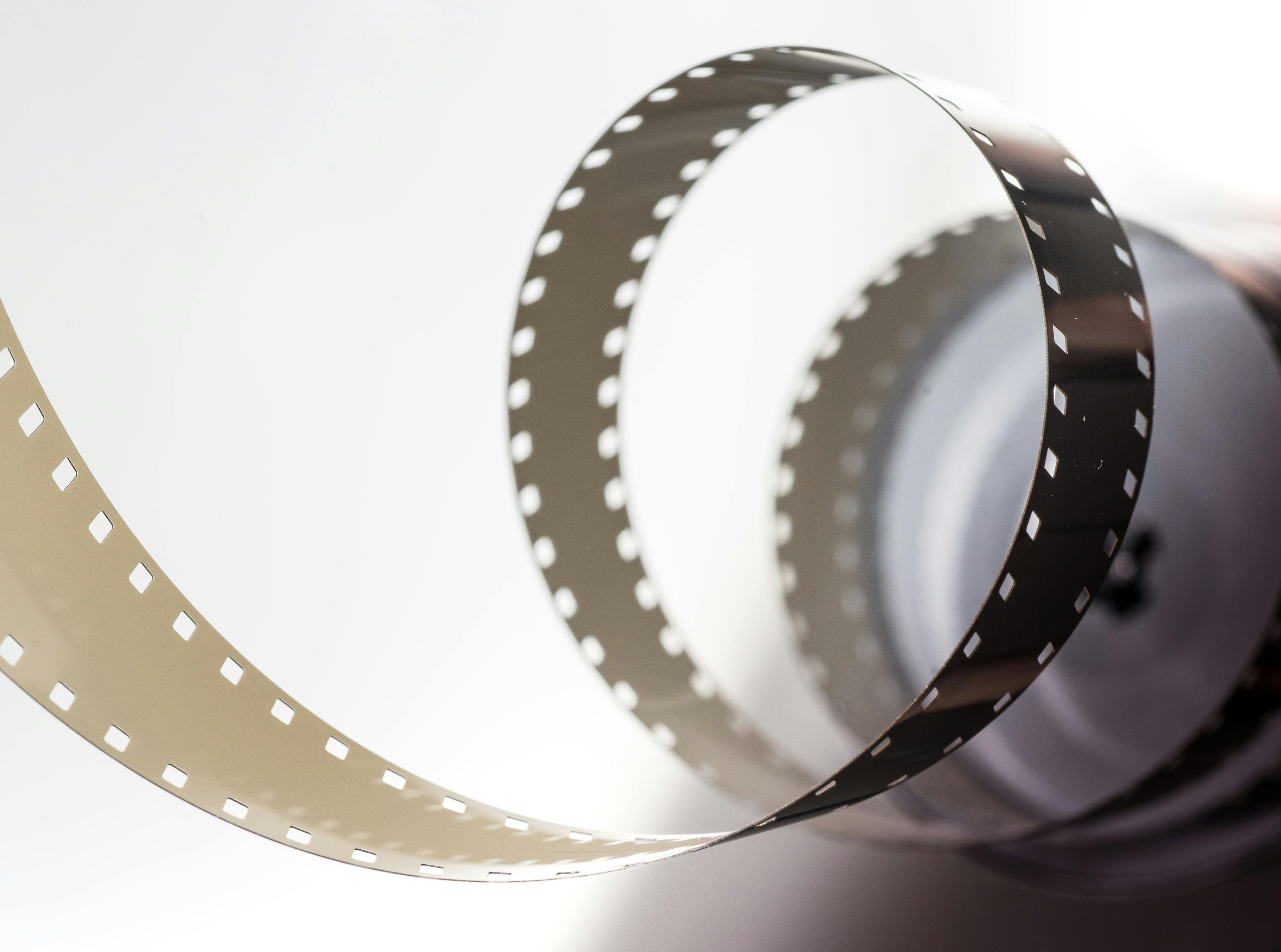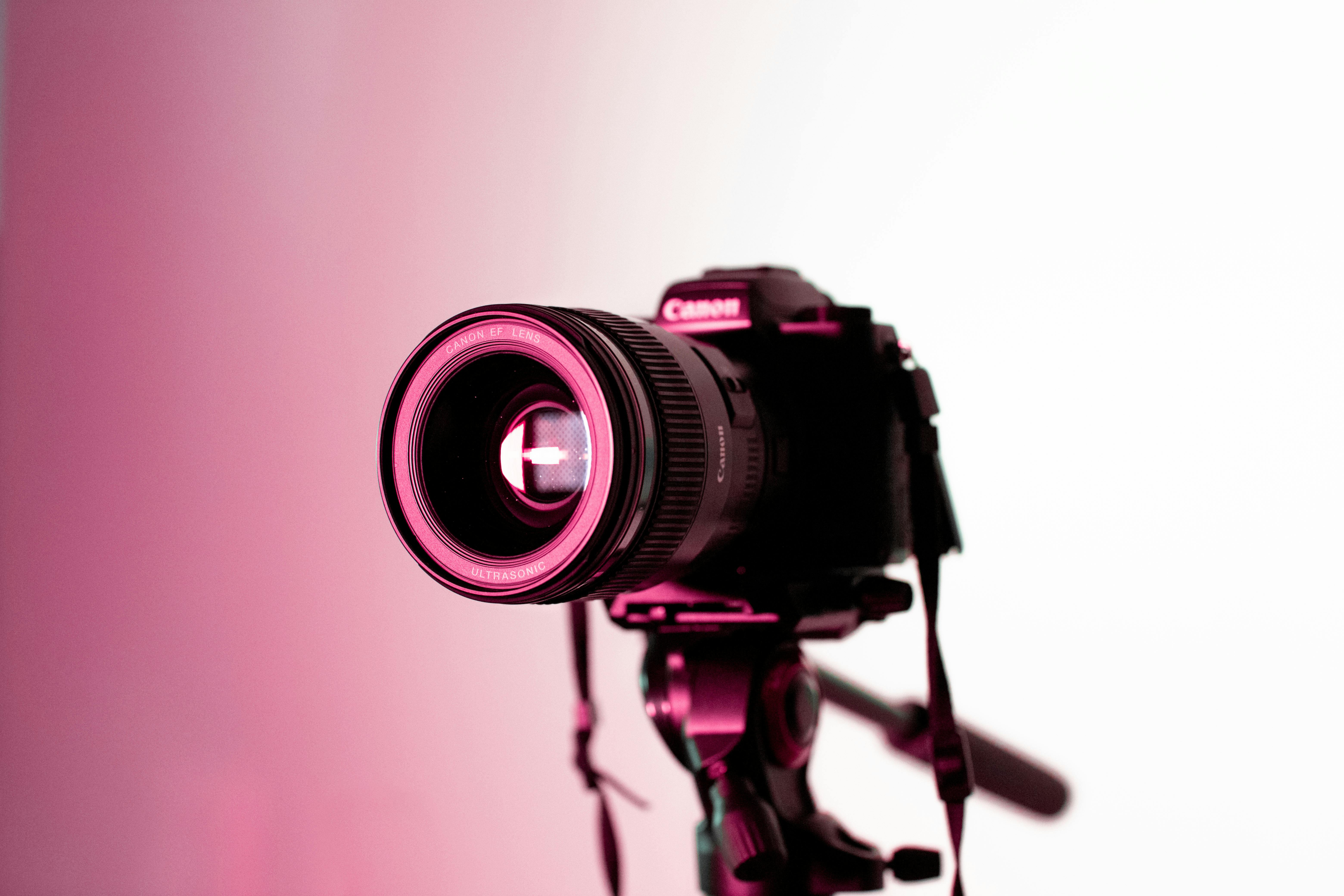- 7 months ago
-
The 2023 summer program was full of highlights. The change of focus to a more mentor-based program was successful and meaningful, where ambitious projects led to outstanding results. Collaborative projects brought exceptional experiences for our budding artists, while our special guest artists played an important role for others. At the Lorge School, Art for Progress purchased musical instruments that will bring a renewed music program this fall. There’s one thing that remains clear and present in the work that we do.
Access to the arts, music, and creative outlets for young people could not be more important than it is right now. Everyone at Art for progress is very proud of what’s been achieved over the last 6 years, and its bittersweet knowing that next year will be our last year.
We set out in May with an ambitious goal of finding students across NYC who could benefit the most from our summer program. We brought posters and flyers to art, music, and fashion schools in the boroughs, hoping to connect with students who were willing to spend some of their precious time off in the summer with us. With the help of many people at the schools, we got a nice response, and ultimately an amazing group of students.
a fun photo collage… The visual arts and music instruction program took place in midtown Manhattan, while the fashion design program was held at designer Gabriel Bullion’s studio in Brooklyn. AFP’s music production program was hosted by Ze Luis Oliveira at his studio in Queens.
One of the main objectives for the 6-week program was to work closely with the students to develop projects that would help them move forward in achieving their goals. Our mentors spent time with each student to learn how we could help support them in their artistic journey. From the feedback we received from our students, we believe this approach was a success.
Some highlights include: a collaboration- students from the music program recorded guitar and bass in the studio (session musicians) on the music production student’s songs, students in the fashion program created their own brands and designed clothing using innovative printing and technology to complete their projects, the visual art students had the opportunity to work with artist Michael Alan on a special project, and we purchased musical instruments to help revive the music program at The Lorge School.
Overall, we had the opportunity to work with some students from the previous summer, and a new group of wonderful students who were excited and eager to learn. It was sad that our program ended for the summer, but we have a feeling we will see many of our students again next year.
Latest News
- 9 months ago
-
by Beláxis Buil
Edited by Global English
Art for Progress’ 2023 summer program kicked off on a different note.
This year’s program was designed to mentor young aspiring creatives interested in pursuing a profession in art, fashion design, music, or film. But what made 2023 so different and special was how the sessions were tailored to help each student achieve individual goals. (In contrast, in 2022 a series of art workshops were offered—such as ceramics, installation art, drawing and watercolor—providing the students with opportunities to explore each medium a bit more, or for the first time.)
So, in 2023, following the first day of orientation at the art department, we began with an introduction to gauge each student’s interest in the arts and how long they have been practicing. Before they began their introduction, I modeled an introduction to help students understand how professional artists customarily introduce themselves to institutions, art galleries, collectors and fellow peers through language and written artist statements. This exercise aimed to situate the student’s mindset into thinking about what is really motivating them to create work and how their work will fit into a broader social conversation.
After the first half of the day, in which students focused deeply on their intentions and why they should think of their practice in terms of words, an array of visual artists such as Kara Walker, Kehinde Wiley, Glexis Novoa, and Roy Lichenstein were exemplified to convey how each of these artists is driven to create work with meaning. Providing examples of artist statements and artworks to the students enabled them to better grasp, visually, the connection between the concept or context behind a work and how those ideas were translated through the use of material.
Over the first week, the visual art students were encouraged to list one to three goals that could be achieved within the six weeks of Art for Progress and implemented in their final portfolio project. Most of the students wanted to improve on their figure drawing techniques and scaling/sizing. Then, each student brainstormed the steps and routines that needed to be put in place to achieve their goals. Having the students determine their goals, consider the time-frame and solidify a routine showed the students their complete autonomy over the creative process and how to hold themselves accountable to produce the work they had committed to. An intensive schedule was created to keep each student on a routine that would allow them to practice drawing techniques and progress over the course of time.
Similarly in the fashion, music and film departments, the mentees worked on their crafts with their mentors.
Gabriel Padilla working with the young designers For example, fashion designers Gabriel Padilla, Seven, and Will engaged the students in creating their own brand and fashion logos. Using current technology in the studio for research and development, the students were on a fast track to the creation of their first garment.
While, at the Atelier Studio, Ze Luis introduced students to his process of music/sound and how his compositions are influenced by ideas. The music/sound students incorporated Ze’s fundamental approach into their own creative processes and experimented to create their own compositions. Through this process, the students caught a glimpse of how professional producers and musicians work in real-time.
Ze Luis working with a student on her song. And finally, in the music department, student’s focused on song structure while exploring various music genres such as jazz, rock and progressive music. Improvised-jam sessions were part of the weekly curriculum as well as discussions on band dynamics. A recording project is slowly developing where the music students will get to perform and collaborate with the music production students at the Atelier Studio.
Jason and John discussing the history of music while demonstrating a variety of music genres to the students.
- 12 months ago
-
Art for Progress (AFP) is set to launch its annual summer program for NYC public school students in July. Now in its sixth year, the program continues to evolve to address the needs of NYC’s young artists and musicians attending public schools across NYC.
The program, funded by The Pierre and Tana Matisse Foundation, offers students interested in careers in the arts and music, summer guidance and instruction. For 2023, the program will shift to a mentorship focused program that offers select students the opportunity to work closely with professional artists across multiple genres including visual art, fashion design, music, and music production.
Teaching artist Paula Parker addressing students- Art for Progress Summer Arts Program The long running program endured the challenging COVID years by creating an impactful online program that continued through 2021. In 2022, Art for Progress was very pleased to receive a three-year renewal for the funding of the program from The Pierre and Tana Matisse Foundation in 2022. With much joy, we returned to normal, in-person programming last year. A focused group of students and our energized teachers made the 2022 program a big success.
Knowing the foundations approach and goals for the summer program, AFP’s Founder Frank Jackson set out to make the 2023 program the best one yet. The message from the foundation has always been, what will you do to improve the program, and how will the program evolve over time to address the needs of NYC’s young artists. In 2022, AFP developed a pilot mentorship program, pairing 7-time Grammy award nominee, composer, arranger, producer, and multi- instrumentalist Ze’ Luis Oliveira with musician, producer, recording engineer Franklin Santiago. The program/experience left a lasting imprint on both artists. Franklin Santiago said, “It was such an amazing experience that I will carry it with me for the rest of my life.” We are very pleased to have Ze’ Luis leading our program in music production, recording and engineering for this years program.
The teachers for the 2023 program are an exceptional group with vast experience as both professional artists, teachers and mentors. They bring the perfect balance of leadership and real world knowledge that young artists desperately need in an increasingly competitive field.
Assistant teacher Jason Mcfarlane leading a drum jam- Art for Progress Summer Arts Program For 2023. AFP is looking for those special students who are ready to take the next step in becoming a professional artist. We are creating a focused program based on mentorship and instruction, where a small group of students will work closely with professional artists who will guide them and prepare them for their next steps in their career development. Art for Progress is looking to work closely with schools across NYC to identify students who will be a great fit for the program. They will also be reaching out to former students of the program who can apply.
The general structure of the program will be four hours a day, or possibly 6 hours a day. Two days per week. A total of 48 hours of programming over 4-6 weeks.
You can apply here. Visit artforprogress.org for updated information. Contact admin@artforprogress.org with questions.
APPLICATION: https://forms.gle/dZUmPMeNQXnECoZh7
- 12 months ago
-
Photography Exhibition, Fotografisca, New York, January 26, 2023 – May 21, 2023
We had the pleasure of visiting the museum and viewing this groundbreaking exhibit last week. The museum alone was a fun, enlightening experience. Rather than the stuffy, quiet, almost sterile environment one comes to expect at a museum, Fotografisca is warm, inviting, and bustling with activity. They encourage you to grab a drink while you view the exhibition. So, that’s what we did.
1985, Josh Cheuse, “Beastie Boys Radio City New York, 1985” The exhibition, featuring many rare works of over 50 artists spans the history of hip hop and the culture. Ranging from iconic staples of visual culture (presented with new context) to rare and intimate portraits of hip-hop’s biggest stars, the works on view traverse intersecting themes such as the role of women in hip-hop; hip-hop’s regional and stylistic diversification and rivalries; a humanistic lens into the 1970s-Bronx street gangs whose members contributed to the birth of hip-hop; and the mainstream breakthrough that saw a grassroots movement become a global phenomenon
1992, Jesse Frohman, “LL, LLCool J” “It’s easy to forget that there was a time before hip-hop was an industry and before it made money,” said Sacha Jenkins, exhibition co-curator and Chief Creative Officer of Mass Appeal, who came of age in New York’s hip-hop scene of the 1980s (b. 1971). “It wasn’t conscious of itself. It was just existing with young people living their lives, dressing as they did, trying to entertain themselves with limited resources and creating an aesthetic that registered amongst themselves. It wasn’t for the world; it was for a very specific community. Then there was an exponentially paced transition where hip-hop culture became a conscious of itself as an incredibly lucrative global export. The exhibition’s lifeblood is the period before hip-hop knew what it was.”
1991, Lisa Leone, “Mary J Blige, New York City, 1991” The exhibition brings audiences through five decades of history, culminating in recent imagery of the biggest names working in hip-hop today. The show, which features archival ephemera to augment the contextualization of its photography, is principally laid out by chronology and geography. Focus areas include but are not limited to the early years, East Coast, West Coast, the South, and the newer wave of artists who have emerged since the mid-aughts.
1993, Sean Mortensen, “Tupac (straight jacket)” Whether you’re a hip hop fan or not, this show is worth a visit to the museum. Artistically, the depth and scope of the work is amazing. From classic snaps in the NYC subway to the shots on the streets across the big apple, the exhibition will bring you back to memories of another day- the music, fashion, culture, vibe.
Congratulations to the museum, the curators Sacha Jenkins and Sally Berman and all of the participating artists.
*ALL IMAGES COURTESY OF FOTOGRAFISKA NEW YORK AND COPYRIGHT OF THE ARTIST *EXCERPTS TAKEN FROM THE OFFICIAL PRESS RELEASE BY MOLLY KRAUSE.
- 1 year ago
-
Great films capture stories that are worth telling, and more and more filmmakers are able to make films because of the evolution of cameras. From the top-of-the-range 35mm and RED cameras used in Hollywood blockbusters to the 16mm and digital cameras used by independent filmmakers, there are a wide range of options available. This allowed filmmakers like Richard “R.G.” Miller to acquire a cheap camera and begin making movies in his early teens.
Today’s movies are being created with new-generation cameras, such as the ones offered by IMAX. An article by The Hollywood Reporter reveals that renowned filmmaker Christopher Nolan has shot Oppenheimer, which focuses on the life of physicist J Robert Oppenheimer, with IMAX film cameras.
If you want to learn more about the different cameras used by various directors, read on.35mm filmmaking cameras
Thomas Edison is credited with inventing the very first 35mm motion picture camera. According to a 2020 No Film School feature titled ‘When Were Cameras Invented?’, Edison and his team developed the device in the early 1980s. Once done, the Kinetograph was able to take a series of photos on 35mm film stock. By 1895, Louis and Auguste Lumiere invented the Cinematographe, which took and projected film.
Since then, most movies were shot on 35mm until digital cameras became more popular. Interestingly, a 2022 Filmmaker write-up shows that various directors continue to debut features that are shot on 35mm. For one, Michael Morris opted to produce To Leslie with 35mm. In the interview with Filmmaker, Larkin Seiple, the movie’s cinematographer, explained that shooting with 35mm allowed them to achieve their desired light looks.Digital SLR cameras
Many movies are now being shot with DSLR cameras. For instance, Noah Baumbach, an independent film director, has utilized these devices to convey realistic narratives. In particular, a Straight From a Movie feature reveals that Frances Ha was shot with a Canon 5D camera. This shows how you don’t need traditional film equipment to capture and celebrate life’s mundanities. This is why the Canon EOS 5D Mark IV is listed as one of the top DSLR cameras on Adorama. Using this widely available camera a director can easily produce smooth and highly-detailed clips. This is because it’s equipped with features like a full-frame, high-speed CMOS sensor, and accurate AF tracking. It likewise boasts powerful processing abilities, so aspiring filmmakers can capture sharp and well-illuminated videos despite being low on budget.
Similarly, Damien Leone, who directed the indie horror sensation Terrifier 2, dedicated most of his funds towards the effects work and makeup. The Collider article explains how horror films that are shot with low-grade DSLRs can generate a creepier atmosphere. By utilizing adequate yet effective equipment like DSLRs, Leone could better produce chilling and unforgettable characters such as Art the Clown.RED cameras
Credit: -Roge- under license CC BY-SA 2.0 No changes were made to the image The RED cameras listed on IndieWire, such as the RED One Model, reveal that when these products became available, they quickly became an important tool for directors and cinematographers. To illustrate, Steven Soderbergh, known for directing Ocean’s Eleven, shot both installments of Che with a RED camera. Apart from Soderbergh, cinematographer Erik Messerschmidt shared in his interview with IndieWire that, “Shooting on film would have significantly limited our creative choices, particularly with focus and depth of field.” Luckily, with RED cameras, Messerschmidt could achieve the level of control he needed when he helped shoot films like The Curious Case of Benjamin Button and Mank.
Currently, RED cameras are a fixture in major studio productions such as Birdbox, Captain Marvel, Entourage, and The Suicide Squad. However, indie filmmakers who are working with low production funding can utilize the RED Komodo, which can seamlessly capture detailed 6K clips.
If you wish to become a filmmaker one day, remember that a large production isn’t necessary to produce meaningful outputs. This article has illustrated that having a reliable camera can help you capture the story you want.

